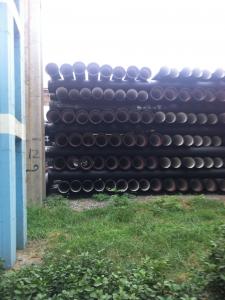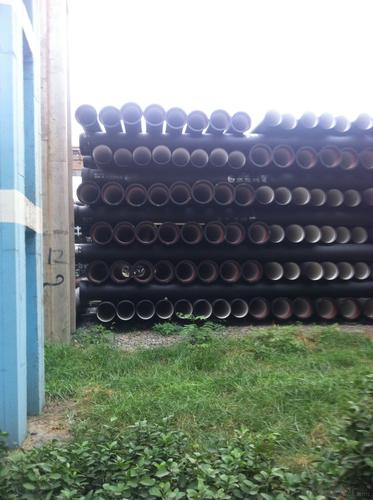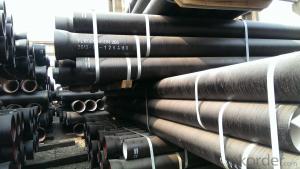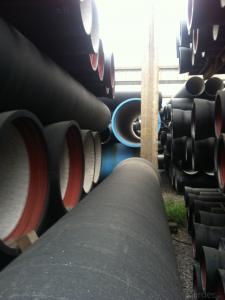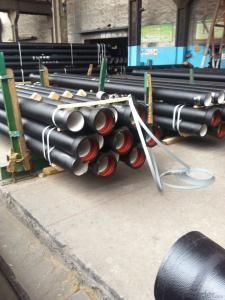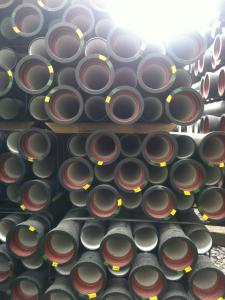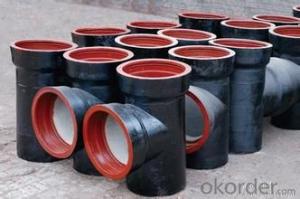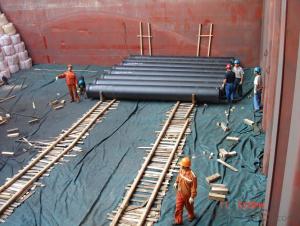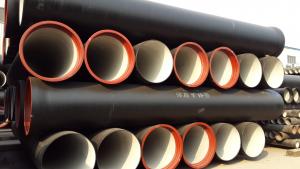DUCTILE IRON PIPE AND PIPE FITTINGS K7 CLASS DN450
- Loading Port:
- Tianjin
- Payment Terms:
- TT OR LC
- Min Order Qty:
- 23 pc
- Supply Capability:
- 3000 pc/month
OKorder Service Pledge
OKorder Financial Service
You Might Also Like
· Material : Ductile Cast Iron
· Size Range : DN 80mm to DN 2000mm
· Unit Effective Length : 6m or 5.7m
· Manufacture Standard: ISO 2531:1998/ EN 545:2006/EN 598:2007
· Annual capacity : 200,000 tons
· Coating Exterior: Zinc 130g/m2 according to ISO 8179-1 and bitumen coating 70 microns.
· Cement Interior: Portland Cement/ High Alumina Cement/ Sulphate Resisting Cement Lining according to ISO 4179
· Special requirements on external coating and internal lining can be applied
· We also provide accessories such as SBR/EPDM rubber gaskets, lubricant paste, pipe caps, PE sleeves, etc.
Additional Parts:
Each pipe is strictly inspected according to related standard to ensure permanently high performance.
Easy Installation at site and service free for life
Long Service Lifespan
Quotation will arrive you within 24hours once we get your inquiry.
We guarantee offering you a competitive price.
A copy of original inspection reports of pipes will be offered after shipment.
Photos of loading process will be sent to the customer after shipment effect.
We will follow-up the delivery progress after shipment effect and update to the customer on weekly basis.
- Q: How can the ductile iron pipe elbow be fixed?
- Ductile cast iron pipe in the groove pipe connection technology is also called the lathedog connection technology, has become the most liquid and gas pipeline connection technology, although this technology is later than foreign in domestic development time, but because of its advanced technology, domestic market quickly received. Since 1998, it has been developed and applied in just a few years. It has gradually replaced two traditional ways of pipe connection, such as flange and welding. Not only technically more mature, the market is generally recognized, but also by the national laws and regulations actively guide the policy. The application of grooved pipe connection technology makes the complex pipe connection procedure simple, fast and convenient. Took a big step forward in pipeline connection technology.
- Q: Are ductile iron pipes suitable for horizontal directional drilling (HDD) installations?
- Ductile iron pipes are indeed suitable for horizontal directional drilling (HDD) installations. Renowned for their robustness and durability, ductile iron pipes prove to be an exceptional option for HDD projects. The process of HDD entails creating a horizontal tunnel underground and inserting a pipe through it. This can be quite challenging due to the immense forces exerted on the pipe during the installation. Nevertheless, ductile iron pipes have the capability to endure these forces and maintain their structural integrity, thus ensuring a successful HDD installation. Furthermore, ductile iron pipes possess outstanding resistance to corrosion, making them suitable for a wide range of soil and environmental conditions frequently encountered during HDD projects. In conclusion, ductile iron pipes possess the necessary characteristics to withstand the demanding conditions of HDD installations and remain a dependable choice for such applications.
- Q: Are ductile iron pipes suitable for installation in areas with high soil compaction and traffic loads?
- Yes, ductile iron pipes are suitable for installation in areas with high soil compaction and traffic loads. Ductile iron pipes have high tensile strength and are highly resistant to external loads, making them ideal for areas with heavy traffic and compacted soil. They are designed to withstand the pressure and stress caused by the movement of heavy vehicles and the weight of the soil above them. Additionally, ductile iron pipes have excellent flexibility, allowing them to absorb and distribute the load more effectively, reducing the risk of damage or failure. Therefore, they are a reliable choice for installation in areas with high soil compaction and traffic loads.
- Q: Can ductile iron pipes be used for underground slurry pipelines?
- Yes, ductile iron pipes can be used for underground slurry pipelines. Ductile iron pipes are known for their strength, durability, and resistance to corrosion, making them suitable for a variety of applications including underground slurry pipelines. They provide a reliable and cost-effective solution for transporting slurry, which is a mixture of solids and liquids, over long distances. The inherent toughness and flexibility of ductile iron pipes allow them to withstand the abrasive nature of slurry and the external loads associated with underground installation. Additionally, ductile iron pipes can be easily joined using various methods, ensuring a secure and leak-free pipeline system. However, it is important to consider the specific properties of the slurry being transported and consult with experts to determine the appropriate pipe specifications and design considerations for the underground slurry pipeline.
- Q: What is the expected fatigue life of ductile iron pipes under cyclic loading?
- The expected fatigue life of ductile iron pipes under cyclic loading can vary depending on various factors such as the material properties, design considerations, loading conditions, and maintenance practices. However, ductile iron pipes are generally known for their excellent fatigue resistance, and when properly designed and installed, they can have a long fatigue life of several decades or more.
- Q: What are the different methods for restraining ductile iron pipe?
- There exist various techniques for restraining ductile iron pipe to prevent any movement or displacement caused by internal pressure, external forces, or ground movement. The most commonly used approaches include: 1. Thrust blocks: Concrete blocks or structures are positioned at bends, tees, or other directional changes in the pipe. These blocks are designed to resist the forces exerted by flowing water or fluids within the pipe, effectively anchoring it in place. 2. Mechanical restraints: Harnesses or clamps are installed around the pipe and affixed to a fixed structure, such as a wall or concrete anchor. These restraints provide a physical barrier that prevents any movement or shifting of the pipe. 3. Pipe restraints: Devices directly attached to the pipe and anchored to a fixed structure, such as pipe clamps, restraints, or saddles. They are designed to securely hold the pipe in place and resist any movement or displacement. 4. Proper pipe bedding and backfill: It is crucial to properly support and surround the pipe with compacted material to prevent any movement or shifting. This method involves carefully placing and compacting soil or suitable materials around the pipe to provide stability and prevent displacement. 5. Trench walls: The walls of the trench where the ductile iron pipe is installed can also contribute to restraining it. By correctly compacting the soil against the pipe and ensuring proper stability of the trench walls, the pipe can be effectively restrained and prevented from moving. Overall, the various methods for restraining ductile iron pipe aim to ensure its secure placement without any displacement or movement. The choice of method depends on factors such as location, application, and the forces acting on the pipe. It is important to consult with engineers and adhere to industry guidelines and standards to determine the most appropriate method for restraining ductile iron pipe in specific situations.
- Q: What are the different types of joints used in ductile iron pipes?
- The different types of joints used in ductile iron pipes include push-on joints, restrained joints, mechanical joints, flanged joints, and welded joints.
- Q: What is a slide in type T flexible interface?
- There are many kinds of cast iron pipe interface. The commonly used interfaces include sliding type (T type) flexible interface, mechanical type (K type) flexible interface, mechanical type (NII type, SII type) flexible interface, flange type interface and special interfaceSliding type (T type) flexible interfaceSlide type (T type) flexible interface as shown below. The ductile interface is widely used in the DN I000mm following the cast iron pipe, has the advantages of simple structure, convenient installation, good sealing characteristics. In the socket structure considering the location of the rubber ring and the deflection angle, this interface can adapt to deformation a certain foundation, has certain anti vibration ability, at the same time using the deflection angle of the long distance pipeline to achieve steering.
- Q: What is the weight of ductile iron pipe compared to other pipe materials?
- Ductile iron pipe is generally heavier than other pipe materials such as PVC or HDPE. Its weight can vary depending on the size and wall thickness of the pipe, but in general, ductile iron pipe is known for its durability and strength, which often results in a higher weight compared to other pipe materials.
- Q: Can ductile iron pipes be used for irrigation pivot systems?
- Yes, ductile iron pipes can be used for irrigation pivot systems. Ductile iron pipes are known for their strength, durability, and resistance to corrosion, making them suitable for various applications including irrigation. These pipes can withstand high water pressure and provide a reliable and long-lasting solution for transporting water to irrigation pivot systems. Additionally, ductile iron pipes are also compatible with various fittings and connectors commonly used in irrigation systems, making them easy to install and maintain. Overall, using ductile iron pipes for irrigation pivot systems is a practical choice that ensures efficient water distribution and minimizes the risk of pipe failure.
Send your message to us
DUCTILE IRON PIPE AND PIPE FITTINGS K7 CLASS DN450
- Loading Port:
- Tianjin
- Payment Terms:
- TT OR LC
- Min Order Qty:
- 23 pc
- Supply Capability:
- 3000 pc/month
OKorder Service Pledge
OKorder Financial Service
Similar products
Hot products
Hot Searches
Related keywords
